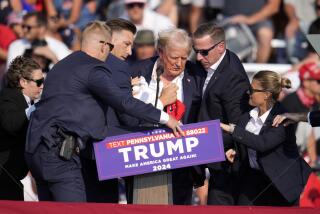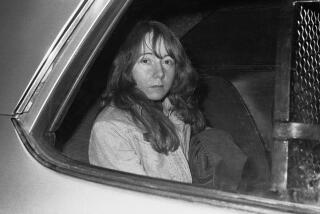A Healthy Skepticism on Warren Commission
Richard Mosk is wrong when he states that conspiracy theories have run their course (Commentary, Nov. 11). All interpretations of the evidence in the Kennedy assassination are theories, because the murder investigation and the autopsy of the presidentâs body were so blotched that we will never know what really happened in Dealey Plaza on Nov. 22, 1963.
The Warren Commissionâs theory is that Lee Harvey Oswald, acting alone, fired three shots at the presidential motorcade in Dallas. One shot missed and two shots struck the president. One of those shots also struck Texas Gov. John Connally. In order for this version of the events to be true, one must accept the âsingle bulletâ theory, which holds that one bullet pierced the presidentâs throat and then entered Connallyâs back and caused severe wounds, including shattering his fifth rib and wrist. The major problem with the single bullet theory is that it is not supported by an analysis of the Zapruder film, the home movie taken of the murder; eyewitness testimony, including that of Connally; and the physical condition of the bullet, which has been preserved in the National Archives.
The truth is that the Warren Commission failed to follow up on significant leads because it had already determined the outcome of the investigation before it started -- that Oswald acted alone. There is nothing âdisturbingâ or âunhealthyâ about questioning the dubious conclusions of the Warren Commission. It is difficult for people to live in doubt about significant events in their lives. But doubt will always be the legacy of the Warren Commission.
Terry Stevenson
Simi Valley
*
Moskâs commentary represents the current fashion among Warren Commission defenders: posit a false choice between the commissionâs report and âbizarreâ conspiracy theories. By so doing, they deter others from examining the real inconsistencies of the âlone gunmanâ explanation, as well as the recently advanced evidence that the Zapruder film was altered, all of which by definition require the actions of more than one individual.
No, Justice Mosk, it is not hard to accept that a single person âcouldâ shoot a president; but it is hard to accept that one person did shoot John F. Kennedy and cause both entry wounds from the rear and from the front (see David Liftonâs âBest Evidenceâ).
Michael Celio
Downey
*
Mosk would have us believe that all is settled regarding Kennedyâs murder. He criticizes âconspiracyâ theories and rightly mocks the Oliver Stone production of âJFK.â All I know is this: From that awful day in Dallas in 1963 to that horrible night at the Ambassador Hotel in 1968, four men who represented the real possibility of making this country into what many of us believe it should be were shot down. They were John F. Kennedy, Malcolm X, Martin Luther King Jr. and Robert F. Kennedy.
Mosk would have us believe this was all coincidence: lone gunmen, nut cases. Maybe so, but when one threatens entrenched interests and their hold on power, history shows that the powerful can and do fight back, up to and including murdering their opponents. Thanks to coincidence theorists like Mosk, we will never know the full truth about what happened to a generation of leaders we may never see the likes of again. And why should we? After all, we just kill them.
D.M. Evans
San Clemente
*
In 1979 the Select Committee ... U.S. House of Representatives concluded that Kennedy was probably killed as a result of a conspiracy. By implying that âpublishers and movie mogulsâ motivate the rejection of the findings of the Warren Commission, Mosk continues the commissionâs modus operandi: distraction and omission. As long as people can read and reason, the Warren Commission will be seen for what it was -- a coverup.
Dennis Pearce
Santa Monica
More to Read
Sign up for Essential California
The most important California stories and recommendations in your inbox every morning.
You may occasionally receive promotional content from the Los Angeles Times.










